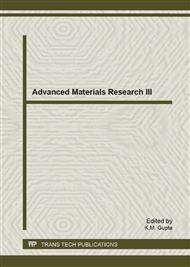p.30
p.35
p.40
p.45
p.50
p.57
p.63
p.68
p.76
Physical and Mechanical Properties of Visible Light Cure Composites Based on Novel Organically Modified Ceramic Resins
Abstract:
Replacement of damaged tooth is necessary for proper functioning and better aesthetics. Polymeric composites based on organic resins are the most popular materials used for restoration of damaged tooth though they have many problems like polymerization shrinkage. The post gel polymerization shrinkage causes significant stresses in the surrounding tooth structure and composite tooth bonding leading to premature restoration failure. Other problems such as uncured organic monomers leaching from the dental composites into the surrounding gum tissue have been reported to cause cytotoxic effects, pulpal necrosis, requiring tooth extraction. The present paper describes the studies on visible light cure composites based on organically modified ceramic resins. Effect of different inorganic materials incorporated during resin synthesis on mechanical properties of photo cured composite was evaluated in terms of diametral tensile strength (DTS), compressive strength (CS) and surface hardness (VHN). The better properties of photocured composites based on the novel organically modified ceramic resin which are hybrid inorganic organic resins may be due to the effective bonding between the organic and inorganic parts within the resin.
Info:
Periodical:
Pages:
50-53
Citation:
Online since:
April 2013
Authors:
Price:
Сopyright:
© 2013 Trans Tech Publications Ltd. All Rights Reserved
Share:
Citation:


